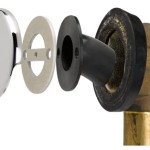How to Effectively Clean Dirty Bathtub Grout
Bathtub grout, a porous material filling the spaces between tiles, is highly susceptible to dirt, mildew, and soap scum accumulation. This accumulation not only detracts from the aesthetic appeal of the bathroom but can also cultivate bacteria and allergens, potentially impacting hygiene and health. Regular and thorough cleaning is essential to maintain the appearance and cleanliness of the bathtub grout.
Several methods can be employed to clean dirty bathtub grout, ranging from common household solutions to commercially available grout cleaners. The choice of method depends on the severity of the staining, the type of grout, and personal preferences. This article provides a detailed guide on various techniques to effectively clean dirty bathtub grout, ensuring a sparkling and hygienic bathroom environment.
Understanding the Nature of Grout and Its Staining
Grout is primarily composed of cement, sand, and water. This combination creates a porous surface that readily absorbs liquids and traps dirt. The porosity makes grout vulnerable to staining from various sources, including soap residue, shampoo, conditioner, body oils, and hard water deposits. These deposits, combined with the warm and humid environment of a bathroom, provide an ideal breeding ground for mold and mildew.
Mold and mildew thrive in damp conditions and manifest as dark, discolored patches on the grout surface. These organisms not only cause unsightly stains but can also release allergens and volatile organic compounds (VOCs) into the air, potentially triggering respiratory problems and allergic reactions. Regular cleaning helps prevent the build-up of these harmful substances.
Different types of grout exist, each with varying degrees of porosity and resistance to staining. Epoxy grout, for example, is less porous than cement-based grout and offers greater resistance to water absorption and staining. However, even epoxy grout requires periodic cleaning to remove surface dirt and grime. Understanding the type of grout in the bathtub is crucial for selecting the appropriate cleaning method and products.
The color of the grout also influences the visibility of stains. Light-colored grout, such as white or beige, tends to show stains more readily than darker grout. Regardless of the grout color, consistent cleaning is the most effective way to prevent stains from becoming deeply embedded and difficult to remove.
Effective Cleaning Methods Using Household Solutions
Numerous household solutions can be effectively used to clean dirty bathtub grout. These solutions are often readily available, cost-effective, and environmentally friendly. Before using any cleaning solution, it is advisable to test it on a small, inconspicuous area of the grout to ensure it does not cause discoloration or damage.
Baking Soda Paste: Baking soda is a mild abrasive that can effectively remove light stains and grime from grout. To create a baking soda paste, mix baking soda with water until a thick, spreadable consistency is achieved. Apply the paste to the grout lines and allow it to sit for several minutes. Scrub the grout with a stiff-bristled brush, such as an old toothbrush or a grout brush, and rinse thoroughly with water. Baking soda is gentle enough for use on most types of grout and is unlikely to cause damage.
Vinegar Solution: Vinegar is a natural acid that can dissolve soap scum and hard water deposits. To create a vinegar solution, mix equal parts white vinegar and water in a spray bottle. Spray the solution onto the grout lines and allow it to sit for several minutes. Scrub the grout with a stiff-bristled brush and rinse thoroughly with water. Vinegar has a strong odor, so ensuring proper ventilation is recommended while cleaning. Vinegar is generally safe for use on most types of grout, but it should be avoided on natural stone tiles, such as marble or granite, as it can etch and damage the surface.
Baking Soda and Vinegar Combination: The combination of baking soda and vinegar creates a fizzing action that can help loosen stubborn stains and grime. Sprinkle baking soda onto the grout lines, then spray with vinegar. Allow the mixture to fizz for several minutes, then scrub with a stiff-bristled brush and rinse thoroughly with water. This method is particularly effective for removing mold and mildew stains. Again, ensure proper ventilation during use.
Hydrogen Peroxide: Hydrogen peroxide is a mild bleaching agent that can help remove stains and disinfect the grout. Apply hydrogen peroxide directly to the grout lines and allow it to sit for several minutes. Scrub the grout with a stiff-bristled brush and rinse thoroughly with water. Hydrogen peroxide is generally safe for use on most types of grout and is a good option for removing mold and mildew stains. However, it is important to note that hydrogen peroxide can lighten the color of dark grout, so testing it on a small, inconspicuous area is recommended before applying it to the entire surface.
Lemon Juice: Lemon juice, like vinegar, is a natural acid that can dissolve soap scum and hard water deposits. Apply lemon juice directly to the grout lines and allow it to sit for several minutes. Scrub the grout with a stiff-bristled brush and rinse thoroughly with water. Lemon juice has a pleasant citrus scent and is a good alternative to vinegar for those sensitive to its odor. As with vinegar, lemon juice should be avoided on natural stone tiles.
Using Commercial Grout Cleaners and Tools
For heavily stained or particularly dirty grout, commercial grout cleaners may be necessary. These cleaners are formulated with stronger chemicals and abrasives designed to penetrate and remove stubborn stains. However, it is crucial to read and follow the manufacturer's instructions carefully when using commercial grout cleaners, as some may contain harsh chemicals that can damage the grout or cause respiratory irritation.
Commercial grout cleaners are available in various formulations, including sprays, liquids, and powders. Some cleaners are specifically designed for removing mold and mildew, while others are formulated for general cleaning. Selecting a cleaner appropriate for the type of grout and the nature of the staining is essential.
When using commercial grout cleaners, wearing gloves and eye protection is recommended to prevent skin and eye irritation. Ensuring adequate ventilation is also crucial to avoid inhaling harmful fumes. After applying the cleaner, allow it to sit for the recommended time, then scrub the grout with a stiff-bristled brush. Rinse thoroughly with water to remove any residual cleaner.
In addition to commercial cleaners, several specialized tools can aid in grout cleaning. Grout brushes, with their narrow, angled bristles, are designed to effectively clean grout lines. Electric grout scrubbers can provide more powerful cleaning action, saving time and effort. Steam cleaners can also be used to clean grout, using high-temperature steam to loosen dirt and grime. However, steam cleaners should be used with caution, as excessive heat can damage certain types of grout or tiles.
For extremely stubborn stains, grout pens can be used to cover up discoloration. Grout pens contain a colored sealant that can be applied directly to the grout lines, providing a temporary fix for stained or discolored grout. However, grout pens do not clean the grout and are merely a cosmetic solution. For long-term results, thorough cleaning is still necessary.
Preventive Measures to Maintain Clean Grout
Preventing grout from becoming dirty in the first place is the most effective way to maintain a clean and hygienic bathroom. Several preventive measures can be taken to minimize staining and the growth of mold and mildew.
Regular Cleaning: Regular cleaning is the most important preventive measure. Wiping down the bathtub and surrounding tiles after each use helps remove soap scum and water deposits before they have a chance to accumulate. A quick wipe-down with a clean cloth or sponge can significantly reduce the need for more intensive cleaning.
Proper Ventilation: Adequate ventilation helps reduce moisture levels in the bathroom, inhibiting the growth of mold and mildew. Running the bathroom exhaust fan during and after showering or bathing helps remove excess moisture from the air. If the bathroom lacks an exhaust fan, opening a window can provide ventilation.
Sealing the Grout: Applying a grout sealant helps protect the grout from water absorption and staining. Grout sealants create a barrier that prevents liquids from penetrating the grout, making it easier to clean and less susceptible to mold and mildew growth. Grout sealants should be reapplied periodically, as the sealant can wear down over time. The frequency of reapplication depends on the type of sealant and the amount of usage the bathtub receives.
Using a Squeegee: Using a squeegee to remove excess water from the tiles and grout after showering or bathing can help prevent water spots and soap scum build-up. A squeegee is a simple and effective tool that can significantly reduce the amount of moisture in the bathroom.
Choosing the Right Cleaning Products: When cleaning the bathtub, choose cleaning products that are specifically designed for use in bathrooms and that are gentle on grout. Avoid using abrasive cleaners or scouring pads, as these can damage the grout and make it more susceptible to staining. Look for cleaning products that are labeled as non-abrasive and pH-neutral.
Addressing Leaks Promptly: Repairing any leaks in the bathtub or shower promptly is crucial to prevent water damage and mold growth. Even small leaks can contribute to moisture build-up, creating a favorable environment for mold and mildew. Addressing leaks as soon as they are detected can prevent more serious problems and maintain the integrity of the grout and tiles.
Implementing a Consistent Cleaning Schedule: Establishing a consistent cleaning schedule is essential for maintaining clean grout. Regular cleaning, even if it is just a quick wipe-down, can prevent stains from becoming deeply embedded and difficult to remove. The frequency of cleaning will depend on the amount of usage the bathtub receives and the type of grout. However, aiming to clean the grout at least once a week is a good starting point.

How To Clean The Grout Between Your Wall Tiles And Revamp Mouldy Mastic

Best Ways To Keep Your Bathtub Looking Clean Tile Grout Cleaning Sealing Caulking Services For Denver

How To Clean Bathroom Tile And Grout Reviews By Wirecutter

How To Clean A Moldy Shower Super Satisfying With Me

How To Clean A Dirty Bathtub At Home With Ashley

How To Clean Dirty Grout With Homemade Cleaner Bathtub Shower Too Andrea Jean Cleaning

How To Clean Your Bathtub The Home Depot

See How A Bathtub Went From Dirty To Spotless Thanks Our Grout Sealing In Boston Ma

How To Clean Grout Two Ingredient Diy Cleaner Lemons Lavender Laundry

We Re The Look Of Tub Showers With Deep Cleaning Grout Masters Inc








